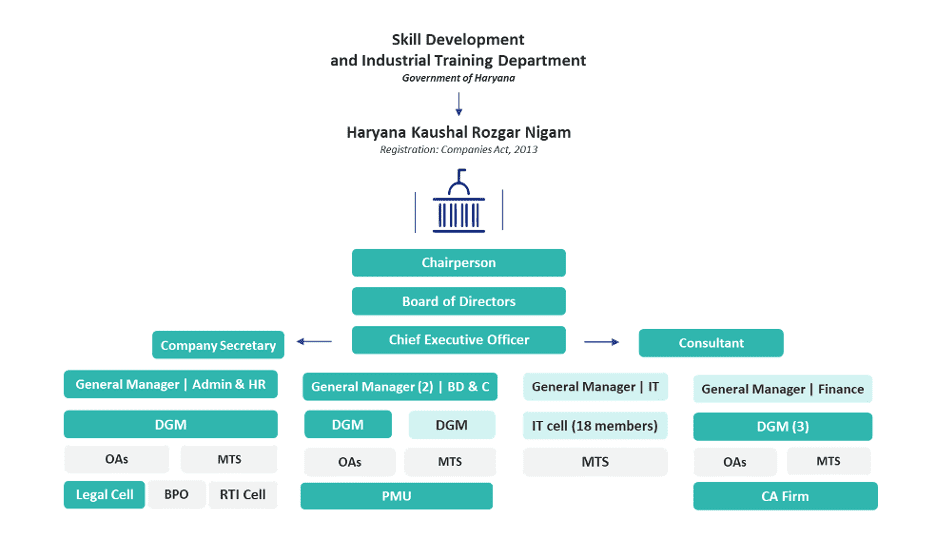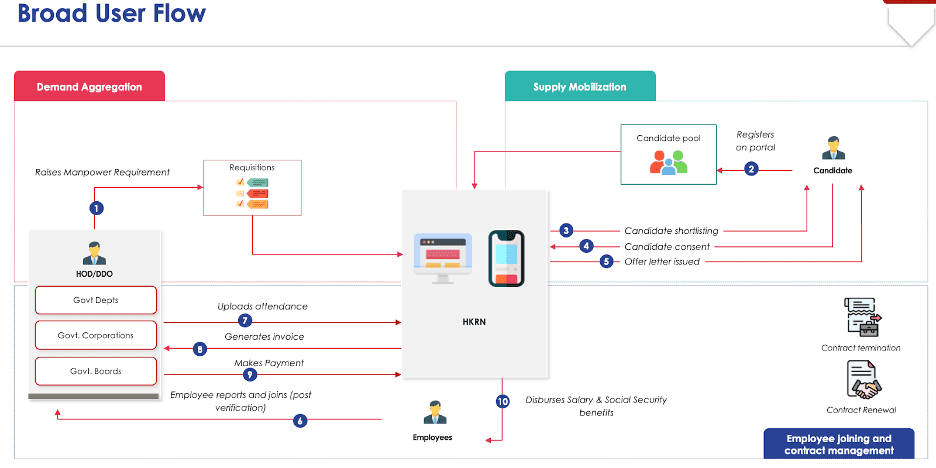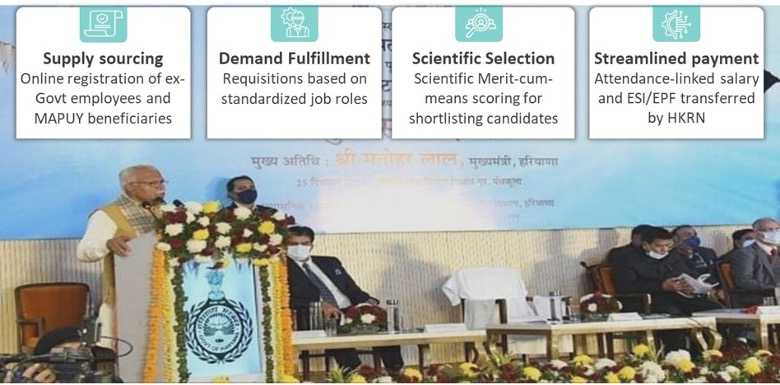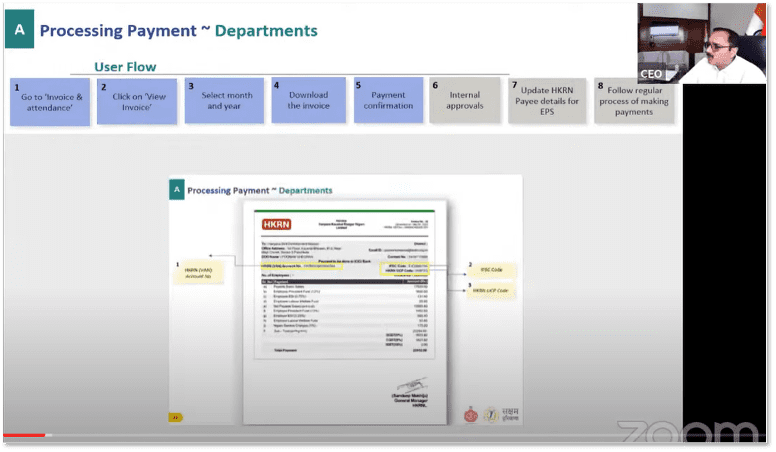Tech-enabled streamlining of hiring and benefits dispersal for contractual government employees
Government jobs have been sacrosanct for all Indians irrespective of their economic class, since the British era. Even with the era of globalization bringing in a plethora of opportunities in the private sector, these jobs are the most sought after. Why does that seem to be the case? The answer lies primarily in the “security” provided through these opportunities. The security of receiving timely salary, leaves, health allowances, paid leaves, various social security benefits, timely promotion, pensions and most importantly - transparent communication and management of any personnel decisions is what makes these government jobs extremely lucrative till date. Along with this, was attached the respect from society that came with holding a government job.
These were the exact expectations of Shanty Kapoor, a contractual employee from Rohtak in Haryana. It was a joyous occasion for him and his family when he was offered a contractual position in the Govt. of Haryana’s Health Department. With the job offer, Shanty and his family felt they now have a sense of security with the benefits offered with the position. Shanty did have to pay the contractor a fairly large sum of money to get the job, but it had all finally come together for them in the beginning of 2020.
Our team met with Shanty while he was running from pillar to post in the Chief Minister’s Office to get what was due to him – his leaves. Shanty narrated his journey of having worked 6 months as a contractual employee in the Health Department, and described the job in the organised government sector, extremely unorganised. His salary for the first month was credited 4 months after starting work and he received only 60% of it. After working for 10 months, he was abruptly transferred to an office 250 kms away from his home district. He learned that this was to accommodate another employee who was given priority over him. After having reached out to his contractor, the contractor simply shrugged off any responsibility and told him to count his blessings of having the job opportunity, and could quit if he had any problems.
Shanty is just one of the 1.5 lakh contractual employees in the state of Haryana who face these problems on a regular basis.
In the health department office in Rohtak, Ravi Sharma, was sympathetic to Shanty’s problems, but he could not change the situation or circumstances for Shanty. He had limited visibility on the employed contractual manpower in the department, as their contract was completely managed by the contractor. About 40-50% of the amount released from the state coffers to pay the wages to the contractual employees would not reach them, as the contractors would keep the same for themselves. It was always a tedious process of getting the contractual manpower recruited. He would have to collect the requirement of manpower from each field office individually. There would almost never be a fixed eligibility criteria defined for the open vacant positions, and there would be unnecessary hiring and unskilled manpower recruited for the positions. As these contracts were also poorly managed, there was high attrition among the contractual employees and the entire recruitment process would have to start again.
This is the story of 200+ departments, 20+ boards & corporations and 40+ PSUs in the state of Haryana.
Challenges related to contractual employment in the Government of Haryana
More than 4 lakh employees work for the Government of Haryana, out of which around 1.5 lakh employees are contractual in nature. These employees are typically employed in Group C (supervisory, operative & clerical assistance) and Group D (routine duties) jobs via contractors and middlemen. This age-old system had challenges for both - the job seekers as well as the government departments.
Job seekers and departments faced issues at the three stages of the recruitment process - before, during and after their recruitment.
- Before Recruitment
The recruitment process was extremely opaque, leading to malpractices and corruption at various levels. Candidates would have to resort to paying bribes to contractors to be able to secure the job opportunity. The departments had to individually collect demand for manpower requirements from each field office which was a tedious and time-taking exercise. The credibility of the demand raised by the field office was low, and the department had limited visibility and power to control this. Along with this, there was no fixed eligibility criteria raised for the manpower to be recruited, and the criteria could be easily tweaked to onboard referrals. The onboarding of a contractor took significant time and effort at the department’s end.
- During Recruitment
Misallocation of jobs and roles was common for the candidates due to the limited portfolio of contractors and manual matching adopted in the process. Further, there was no system to provide the required support for the underserved groups during this process. For the departments, there was limited visibility on the manpower being recruited as the contractors had no accountability to the department to carry out the recruitment in a meritocratic manner.
- After Recruitment
Once recruited, the contractual employees were highly dependent on the contractors for their salaries & other benefits and faced constant threat of contract termination. The contractors exploited the employees by delaying disbursement of salaries up to six months, charging illegal monthly commission ,and not accruing the various social security benefits such as ESI/EPF/leaves as per their contract. The departments had no visibility to track/identify the employed manpower, as that was completely managed by the contractor The efficacy of the government departments was impacted due to the unskilled manpower onboarded & high attrition rates due to the poorly managed contracts.
HKRN as a solution
To counter these inefficiencies faced by the job seekers and the departments, Haryana Kaushal Rozgar Nigam (HKRN) was envisaged as a solution to put an end to the inefficient and opaque system of government contractual hiring.
HKRN was envisioned by the Government of Haryana as a tech-enabled platform for the streamlining of hiring and benefits disbursal for all contractual government employees.
Two major reforms were envisaged as part of the establishment of HKRN as a solution platform - the first was the establishment of a central nodal body to facilitate the staffing and contract management of these employees; the second was the establishment of the tech-enabled HKRN Portal as a one-stop shop for digitalisation of all processes pertaining contractual manpower recruitment and management.
- HKRN as a central nodal body
As a centralized nodal body, the scope of HKRN included all existing and new contractual employees to be hired by all departments, bodies , and boards of the Haryana Government. This required the porting of all existing employees to HKRN and any recruitment of contractual employees to take place solely through HKRN. The nodal body was responsible for standardizing all job roles with a fixed eligibility criteria and fixed wage. The nodal body ensured that the entire selection process was conducted in a meritocratic way with clearly defined Service Level Agreements (SLA) at each and every recruitment and employment stage. With the setup of the central nodal body, contractors were no longer in the equation and HKRN was responsible for the end-to-end recruitment and contract management of all contractual employees working for the Government of Haryana.
Fig : Organisation Structure of HKRN (2023)
- HKRN Portal as a multi-sided tech platform
The HKRN Portal was envisioned as a multi-sided tech platform, catering to 3 major stakeholders -
- The employer i.e., the various departments/bodies/boards of the Government of Haryana,
- The job seeker or the candidate,
- The contractual employee (recruited candidate)
For employers, the portal was envisioned to provide end-to-end facilities related to both recruitment and contract management. For recruitment, HKRN portal planned to provide facilities related to porting of existing contractual manpower and vacancy requisitioning for new manpower requests. For contract management, HKRN Portal provided services related to attendance management, ID Card generation, payment wallets, and creating sub-logins for employee management at the field officer level.
For the job seekers, 4 main facilities were provided -
- Registration of candidates: To fetch applicant’s demographic information, HKRN sourced the data from Parivar Pehchan Patra (PPP), which contains authentic, verified and reliable data of all families in Haryana.
- Verification and approval of previous work experience: Based on a scientific matching algorithm, the portal matched the jobs with the candidates with the relevant eligibility criteria and experience.
- Notification or communication of selection: An efficient communication layer was established to automate all communication to the candidate - for each and every stage.
- Job Matching: The scientific algorithm was designed to minimise any possible misallocations of job location and provide the correct job & salary band to the candidate.
For the employees, the HKRN Portal acted as a Human Resource Management System (HRMS) to handle employee management, tracking leaves and attendance, get pay slips and experience letters. Once onboarded, disbursal of all benefits such as salary, ESI, and EPF were automated. To keep the overall management of the HKRN under control, a centralized dashboard was created to ensure effective monitoring and evaluation.
Various tech modules were established to enable the following core services to ensure this multi-sided interaction of stakeholders:
- Proprietary candidate matching algorithm - This is based on 4 key building blocks - merit based shortlisting, geo-distance based scoring, ease of deployment ranking, and smart updation based rejection pattern.
- Employee payment - This module enables tracking receipt of funds from departments and disburses salaries to the employees via payment gateway.
- Grievance redressal - This module collects lodged grievances, assigns tickets to the state tech team, and provides solutions to the end user.
- Analytical dashboards - This module enables monitoring and evaluation of candidate deployment, employee performance ratings, and employee payment processing timelines.
Fig : User flow for HKRN Portal
Setup of HKRN
The setup of the HKRN solution design was done in the following stages:
-
Cabinet Approval, Corporation Setup & Policy Formulation
HKRN as a solution platform got approval from the Cabinet in August 2021. Post the approval, the operational, legal and admin setup was kicked off. Wage rates were fixed and finalised by the job roles, district categories & work experience required. The HKRN organization was established as a company for deployment of manpower in government departments. A new company was set up under Companies Act 2013 within the Skill Development and Industrial Training Department, Government of Haryana. A dedicated team was onboarded under the aegis of the Board of Directors as per the organisation structure envisioned. Along with this, the Deployment of Contractual Persons Policy, 2022 was approved and notified to streamline the recruitment and contract management of contractual employees in the departments of the Government of Haryana.
-
Tech Development
Simultaneously, with the setup of the organisation, a detailed scoping of the tech modules required was carried out. Detailed user research was carried out to create comprehensive user journeys of all the stakeholders. On the basis of this, the job algorithm was developed, primarily taking into account the behaviour of a typical job seeker in Haryana.
-
Launch
The HKRN portal was launched by the Hon’ble Chief Minister of Haryana, Shri Manohar Lal on November 1, 2021, two months ahead of the planned date.
Fig : Launch of HKRN
-
Adoption
To ensure quick adoption by all government departments and bodies, 4 key levers were identified-
-Training and capacity building of the employers - Multiple online and offline training sessions were held around HKRN processes as well as troubleshooting sessions across the various government departments.
- Continued upgradation of UI - Based on user feedback, regular upgrades were made to the user interface of the portal. For example, enhancements in the candidate registration module led to 40% reduction in registration time.
- Strong redressal system - Multi channel redressal system was established to cater to grievances of both employer and employee. SLAs were established and were monitored closely through an analytical dashboard.
- Institutionalized Review and Monitoring - Regular reviews were done to ensure timely action. For example - penalty clause was approved in policy to ensure non-compliance.
Fig : Session on training and capacity building around HKRN processes
Impact of HKRN
With HKRN, Shanty received the dignity of employment he had envisioned while he was applying for the position of a contractual employee. He would now timely receive his salary on the 7th of every month, along with the provision of paid leaves and all social security benefits he was entitled to. His preferred job location was now taken into account, and he would be able to work in his home district itself. He also would receive the complete amount of salary that was owed to him. The job has returned to Shanty and his family’s lives.For Mr. Ravi Sharma, he was happy that the selection of the contractual manpower was based on a standard eligibility criteria & took place in a meritocratic way, he would receive qualified manpower, avoiding any loss in work. With the dashboards available on the HKRN Portal, the tedious task of collecting requirements from the field offices was no longer needed. He had complete visibility over all the employed manpower and the high employee satisfaction kept the attrition rates low too.
Over the past 2 years, HKRN has transformed the way government contractual employment takes place in Haryana. It has not only plugged financial leakages for the employers but also provided dignity of labor to the contractual employees in Haryana.
For the employees :
- 1 lakh+ existing contractual employees have already been ported to HKRN, and more than six thousand fresh recruitments have been completed and deployed
- 42% of the newly offered jobs have been given to reserved category candidates
- 15% of the jobs have been offered to Antyodaya Family (annual family income < INR 1.8 lakh)
- 67% reduction in job onboarding time for contractual employees
- 90%+ employees receive salaries & social security benefits such as ESI and EPF on time
- 90% employees saw increase in their in-hand salaries; 70% income increased at-least by 20%
- 85% of interviewed (internal survey) contractual employees recommended HKRN
For the employers:
- 100% of government departments carry out authentic requisitions and selections
- 3% attrition rate; substantial decrease since HKRN
- 80%+ departments reported time saved due to online approvals
- 92% departments reported improved quality of manpower
- 84% employers reported high satisfaction with HKRN
The successful implementation of HKRN in Haryana, acts as a model for other governments to adopt in India. The tech-first model will not only plug financial leakages for the financially strained state governments but will also ensure better working conditions for the employees. Sustained political will and bureaucratic championship at all levels is a must-have to enable a new way of life in other states.
This blog is part of the Amrit Series, where we bring to you success stories of large scale impact through our work across domains and states. You can learn more about HKRN here.




